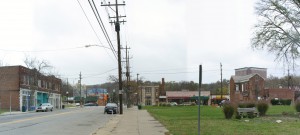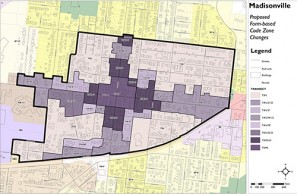
Madisonville is a neighborhood located 10 miles northeast of downtown Cincinnati, Ohio. When Vice Mayor Roxanne Qualls introduced the idea of a Form-Based Code for the city some five years ago, all Cincinnati neighborhoods were invited to learn more about the FBC and what it would mean for their development. Cincinnati’s FBC replaces the city’s traditional zoning code, allowing for a flexible mix of uses within a single building rather than separating buildings by uses. Numerous workshops and meetings were held and Madisonville was one of four neighborhoods that signed on early to participate in the process. Neighborhoods that had showed a commitment to adopting the FBC and that could raise money to support the effort were given the opportunity to participate in a neighborhood-specific charrette.
The Cincinnati City Council unanimously approved its new Form-Based Code in May—it officially took effect on June 7. The Madisonville Community Council was quick to move forward with the process of approving its Regulating Plan created as part of the Focus Neighborhood Charrette process. In late September, the Cincinnati Planning Commission approved Madisonville’s plan. In early October it went before the city council’s Livable Communities Committee and was passed unanimously by the full city council the next day. The Madisonville Regulating Plan will officially take effect on November 9.
“Madisonville is the first of our four pilot neighborhoods in Cincinnati to implement the Form-Based Code in their compact walkable area with city planning commission and city council passage of their vision and regulating plan. The Department of Planning and Buildings is thrilled to have partnered [with Madisonville to make it to] this monumental point in the process. We really look forward to the results and success stories in our neighborhoods that will result from the Form-Based Code,” said Charles C. Graves III, the Director of Cincinnati’s Department of Planning and Buildings in a press release.
The Madisonville Community Urban Redevelopment Corporation is a local organization focused on preserving the historic neighborhood and boosting economic development, as well as assisting in all aspects of community improvement. Following the adoption of the Madisonville Regulating Plan, the community will need to select a developer to guide future work. The MCURC will work with the City of Cincinnati and the greater community to prepare the RFQ, interview potential developers, and select the best developer for the neighborhood. “We will work in partnership with the community and the developer to ensure the best development for Madisonville,” said Sara Sheets, the MCURC’s executive director.

There are already several FBC-based projects in development, said Sheets. The community has site control of four blocks of property in the heart of the neighborhood’s business district, two of which are mostly empty. The MCURC is working with an architect on a feasibility study for a neighborhood health center that it hopes will serve as an anchor tenant in a new mixed-use development. The group expects to issue RFQs early next year for that project and for another project across the street.
“The opportunity to develop a Form-Based Code for Madisonville caused the community to dream bigger and to expect better. Future development will capture the unique character of the neighborhood and will make Madisonville a destination once again because of our focus on building our streets, sidewalks, and new buildings with people as our number one priority,” said Sheets. She later added that “[e]conomic and demographic data suggest that Madisonville is ripe for revitalization and [the MCURC thinks] the FBC can contribute to creating a walkable, interesting, unique sense of place.”
College Hill, a neighborhood on Cincinnati’s northwest edge, is set to take its regulating plan to the City Planning Commission on November 1, while Walnut Hills, located near the center of the city is slated for November 15. The Westwood Regulating Plan is in progress but not yet ready to be considered by the City Planning Commission.
Opticos worked with the City of Cincinnati to establish a form-based approach to the city’s Comprehensive Plan and the Citywide Land Development Code Update. The effort aimed to educate the community and its decision makers about the benefits of Form-Based Coding, create a Form-Based Code, and manage neighborhood planning and charrette processes to implement the FBC. The Form-Based Code is intended to apply to 42 neighborhoods throughout the city, making it one of the largest applications of Form-Based Coding in the country.
Images by Opticos Design/Courtesy of the City of Cincinnati Department of Planning and Buildings.